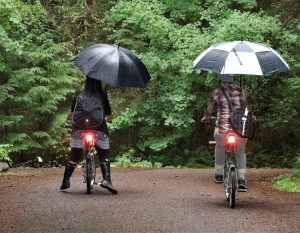 As you all know, the carefree, sun-kissed, easy breezy riding days of summer are now behind us and we’re well into the “yuck months” in most of the country. Temperatures have dropped, rain, fog, and frost have arrived, and yet you’re still not done riding– you still want to get your miles in. And you’re definitely not ready to admit defeat and sequester yourself to a trainer in that dark corner of basement that smells like wet newspaper and sadness. So what’s a cyclist to do?
As you all know, the carefree, sun-kissed, easy breezy riding days of summer are now behind us and we’re well into the “yuck months” in most of the country. Temperatures have dropped, rain, fog, and frost have arrived, and yet you’re still not done riding– you still want to get your miles in. And you’re definitely not ready to admit defeat and sequester yourself to a trainer in that dark corner of basement that smells like wet newspaper and sadness. So what’s a cyclist to do?
Not to worry, our buddies at Showers Pass know a thing or two about this subject and they gave us some tips on the types of gear that will keep you pedaling in comfort throughout your fall/winter riding.*
When it comes to colder weather cycling, there are three main categories you’ll want to consider: breathability, waterproofing and windproofing. If you can find an item with all three, you’re golden. Two out of three ain’t bad. And one out of three is better than nothing.
Breathability is important so that you don’t feel like you are baking away inside a plastic bag. There is a fine line between “warm and dry” and “overheating in your own juices”, so a garment’s ability to jettison moisture and excess heat without letting the elements in is key. Showers Pass recommends looking for something with a breathable fabric or membrane and strategically placed vents.
Waterproofocity is fairly easy to achieve but becomes more tricky when working in conjunction with breathability. Luckily, science has developed several magical techniques for letting sweat escape without letting precipitation in. The only snag is that the more waterproof the material, the less breathable it becomes. Staying dry is incredibly important in cold weather and can be the difference between a brisk but enjoyable ride and hypothermia.
And finally, let’s talk about windproofing. Windproof gear is indispensable since it is often lightweight and can be easily stashed in a back pocket when you don’t really need it. Wind can chill you to the bone but a thin layer between you and it can really save the day. This is especially true when you have worked up a bit of a sweat, like when grinding up a hill, only to crest the summit and be met with a teeth-chattering descent. If the weather is dry, then you can get a lot of riding in as long as you have adequate windblocking. And don’t just focus on your core– your ears, your feet, your knees, and you hands all feel the bite when not protected from the wind.
Disclaimer *If you are reading this and you spend your winters in a reasonable climate, please disregard and carry on as usual.